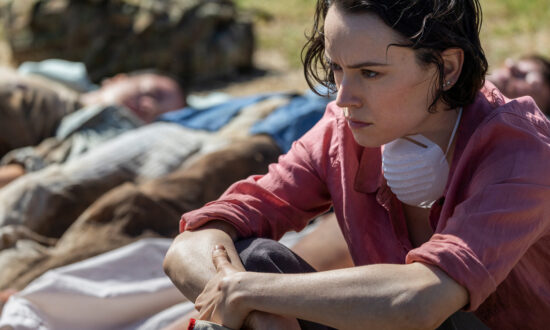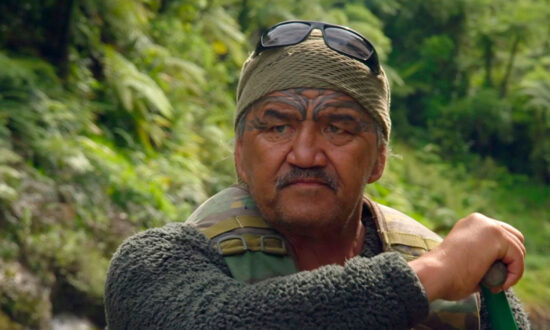In the last documentary series she presented for ABC TV, Rachel Griffiths explored the story of the 100-year-old Archibald Prize. Now she’s returning to the small screen with Great Southern Landscapes, a show the network describes as “another entertaining cultural romp through time and place”, but this time with more places and fewer faces.
“This vast southern continent has captured the imagination of our artists for millennia,” the actor says at the start of the six-part series, which sees her track down six Australian artworks and travel to the spots where the artists captured the scenes, uncovering the personal and cultural stories behind them along the way.
Melbourne-based art historian, writer and curator Chris McAuliffe selected a shortlist of artworks for Griffiths to choose from for each episode, based around six themes: rivers, cityscapes, the outback, beaches, wilderness and lakes.
The focus of the first episode is Arthur Streeton’s evocatively titled 1896 painting The purple noon’s transparent might, which depicts the Hawkesbury River in New South Wales. As well as retracing Streeton’s steps and visiting the National Gallery of Victoria to see the painting, Griffiths also speaks with a Darug woman who explains why the Hawkesbury is a sad place for her people, and looks at the devastation wreaked by recent flooding.
McAuliffe tells InReview that in selecting the featured artworks and landscapes, he and Griffiths tried to focus on “an enchanting place, powerful histories, strong memories and an artist who really invested in the place… artists who keep going back, who become connected to the place and try to understand it more”.
While Great Southern Landscapes explores the dialogue between the artwork and the landscape, it also highlights the stories these embody.
“One of the first things I said to Rachel was technically, the word landscape in the English language, its derivation is from an earlier word meaning land that has been modified from human activity,” McAuliffe explains, “… when we say landscape we mean an element of nature that has been shaped by human intervention, either very obviously in a city or very subtly over decades or centuries, so there has to be a story in there.
“It’s not just a spot – it’s a spot and its history and the lives that were lived there and the activities that were undertaken there and the changes that it’s undergone.”

Rachel Griffiths and Chris McAuliffe with the artworks shortlisted for the beach episode of Great Southern Landscapes. Photo: ABC
In episode three, Griffiths travels to Lake Eyre / Kati Thanda in far north South Australia to see where John Olsen drew inspiration for a 1975 painting simply titled Lake Eyre. While the remoteness of the large salt lake and the way it changes dramatically depending on rainfall give it an air of mystery, McAuliffe says Olsen’s work also represents how artists saw and depicted the Australian landscape differently when they began looking at it from a plane.
“Lake Eyre is an absolute pivot – it’s mysterious, it’s surrounded by mythology. Artists like Olsen captured it in the end, but in really quite innovative ways that changed our perspective on the landscape.”
Olsen’s Lake Eyre is a dramatic abstract painting. McAuliffe says that when viewing it, you can almost feel the plane circling, watching the shapes, textures and colours shifting in front of you.
“I wanted Rachel and the viewers to think, hang on a minute, you can engage with a landscape and capture its mood, its physicality and its space without being meticulously representational or romantic or poetic… it’s big and it’s expansive but it’s gritty and textured and shimmering… it’s a very distinctive moment in Australian art when artists shift to speaking about the landscape with an abstract voice.”

Artist John Olsen with Great Southern Landscapes presenter Rachel Griffiths. Photo: ABC
While Lake Eyre is the only South Australian landscape Griffiths visits in the series, she goes to the Art Gallery of South Australia to view two of the other featured artworks, both of which are part of AGSA’s collection. One is Clarice Beckett’s Luna Park (1919), included in the gallery’s hugely successful Beckett exhibition last year, and the other is Albert Namatjira’s Rutjipma – Mount Sonder (c. 1954).
The delicate watercolours used by Namatjira to depict the mountain in the Northern Territory’s West MacDonnell Ranges may appear similar to the European landscape painting style, McAuliffe says, but research has shown the artist embedded his traditional cultural knowledge into his landscapes. “So it’s a great story of the way Indigenous cultures survive by being flexible and responsible – they take up a new language and a new tool with watercolour painting, but they keep talking about their traditional cultural knowledge, and that’s a really powerful idea…”
He adds: “When Rachel gets there, like a lot of people, she’s just blown away by the landscape.”

Albert Namatjira’s Rutjipma – Mount Sonder, c.1954, watercolour on paper, 28.5 x 38.0cm, Art Gallery of South Australia.
The beach – one of the most powerful motifs in Australian culture – is embodied in an image of Perth’s Cottesloe Beach by South Australian photographer Narelle Autio which leads Griffiths to Western Australia. Titled Splash, the 2004 photo seems to encapsulate summer, with swimmers splashing in the sea in the foreground and a historic beach pavilion in the background.

Get InReview in your inbox – free each Saturday. Local arts and culture – covered.
Thanks for signing up to the InReview newsletter.
“Again, it’s a classic,” McAuliffe says. “It’s one of those beaches that’s just deeply embedded in the memory of West Australians… Narelle literally circumnavigated Australia on a photographic project, so she’s got a really profound interest in Australians’ relationship with water.”
As well as encouraging a deeper appreciation of our landscapes, McAuliffe hopes the television series will stimulate broader interest in Australian art and the stories it encompasses.
“That’s the mission. I’ve been involved in art all my life and when museums do audience surveys, the number-one reason people give for not going to an art gallery is that they say that kind of thing’s not for them. I’m quite the opposite – I think art is for everyone, and particularly the stories that Rachel’s telling.”
Great Southern Landscapes premieres on ABC TV and ABC iview on Tuesday, August 9, at 8pm.
Support local arts journalism
Your support will help us continue the important work of InReview in publishing free professional journalism that celebrates, interrogates and amplifies arts and culture in South Australia.
Donate Here




